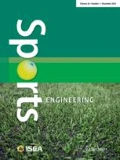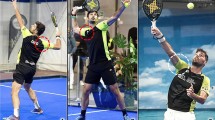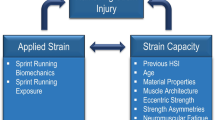Abstract
The existing knowledge of traction on artificial turf is based almost exclusively on mechanical devices. While most attention has traditionally been concentrated on rotational traction, sports such as soccer predominantly involve translational movements. The aim of the study was to investigate whether translational traction at the shoe-surface interface differed between various third-generation artificial turf systems in combination with different cleat configurations in vivo. Twenty-two male soccer players performed five short sprints with a 90° cut over a turf-covered force plate for each combination of three turf systems and three cleat configurations. The results showed that, despite various differences in other traction measures, traction coefficients were almost identical across turf systems and cleat configurations.





Similar content being viewed by others
References
Fédération Internationale de Football Association (2009) FIFA quality concept for football turf. Handbook of Requirements. May 2009 edition. http://www.fifa.com/mm/document/afdeveloping/pitch&equipment/68/52/08/fqcrequirementsmanual%28may2009%29specimen.pdf. Accessed 8 Nov 2011
Fédération Internationale de Football Association (2011) FIFA Laws of the Game. http://www.fifa.com/mm/document/affederation/generic/81/42/36/lawsofthegame_2011_12_en.pdf. Accessed 15 Feb 2012
Dragoo JL, Braun HJ (2010) The effect of playing surface on injury rate. A review of the current literature. Sports Med 40(11):981–990
Norske Idrettsutøveres Sentralorganisasjon (2007) NISOs arbeidslivsundersøkelser. Kunstgress 2007: 84% foretrekker naturgress. http://www.niso.no/innhold/174/kunstgress-2007%3A-84-%25-prosent-foretrekker-naturgress. Accessed 13 Jan 2012
Norske Idrettsutøveres Sentralorganisasjon (2007) NISOs arbeidslivsundersøkelser. Kunstgress 2007: -Flest skader på kunstgress. http://www.niso.no/innhold/177/kunstgress-2007%3A-flest-skader-pa-kunstgress. Accessed 13 Jan 2012
Bonstingl RW, Morehouse CA, Niebel BW (1975) Torques developed by different types of shoes on various playing surfaces. Med Sci Sports 7:127–131
Shorten M, Hudson B, Himmelsbach J (2003) Shoe-surface traction of conventional and in-filled synthetic turf football surfaces. In: Milburn P, Wilson B, Yanai T (eds) Proceedings XIX international congress of biomechanics. University of Otago, Dunedin
Frederick EC (1993) Optimal frictional properties for sport shoes and sport surfaces. In: Hamill J, Derrick TR, Elliot EH (eds) Biomechanics in sports XI. In: Proceedings of the XIth symposium of the international society of biomechanics in sports, vol 11. University of Massachusetts, Amherst, MA, pp 15–22
Villwock MR, Meyer EG, Powell JW, Fouty AJ, Haut RC (2009) The effects of various infills, fibre structures, and shoe designs on generating rotational traction on an artificial surface. J Sports Engng Technol 223(1):11–19
Livesay GA, Reda DR, Nauman EA (2006) Peak torque and rotational stiffness developed at the shoe-surface interface. Am J Sports Med 34(3):415–422
Villwock MR, Meyer EG, Powell JW, Fouty AJ, Haut RC (2009) Football playing surface and shoe design affect rotational traction. Am J Sports Med 37(3):518–525
Severn AK, Fleming PR, Dixon N (2010) Science of synthetic turf surfaces: player-surface interactions. Sports Technol 3(1):13–25
Kuhlman S, Sabick M, Pfeiffer R, Cooper B, Forhan J (2009) Effect of loading condition on the traction coefficient between shoes and artificial turf surfaces. J Sports Engng Technol 224:155–165
Severn AK, Fleming PR, Clarke JD, Carré MJ (2011) Science of synthetic turf surfaces: investigating traction behavior. J Sports Engng Technol 225:147–158
Sabick M, Cooper B, Kuhlman S, Pfeiffer R (2009) Balancing risks, rewards of athletic shoe traction. Lower Extremity Review, October 2009. http://www.lowerextremityreview.com/article/balancing-risks-rewards-of-athletic-shoe-traction. Accessed 20 Apr 2010
Wannop JW, Luo G, Stefanyshyn DJ (2012) Footwear traction at different areas on artificial and natural grass fields. Sports Eng 15:111–116
Sterzing T, Müller C, Milani TL (2010) Traction on artificial turf: development of a soccer shoe outsole. Footwear Sci 2(1):37–49
Kirk RF, Noble ISG, Mitchell T, Rolf C, Haake SJ, Carré MJ (2007) High-speed observations of football-boot-surface interactions of players in their natural environment. Sports Eng 10:129–144
Cawley PW, Heidt RS Jr, Scranton PE Jr, Losse GM, Howard ME (2003) Physiologic axial load, frictional resistance, and the football shoe-surface interface. Foot Ankle Int 24(7):551–556
Heidt RS Jr, Dormer SG, Cawley PW, Scranton PE Jr, Losse G, Howard M (1996) Differences in friction and torsional resistance in athletic shoe-turf surface interfaces. Am J Sports Med 24(6):834–842
Alentorn-Geli E, Myer GD, Silvers HJ, Samitier G, Romero D, Lázaro-Haro C, Cugat R (2009) Prevention of non-contact anterior cruciate ligament injuries in soccer players. Part 1: mechanisms of injury and underlying factors. Knee Surg Sports Traumatol Arthrosc 17(7):705–729
Andréasson G, Lindenberger U, Renstrom P, Peterson L (1986) Torque developed at simulated sliding between sport shoes and an artificial turf. Am J Sports Med 14:225–230
Bowers KD, Martin RB (1975) Cleat-surface friction on new and old AstroTurf. Med Sci Sports Exerc 7(2):132–135
Newton R, Doan B, Meese M, Conroy B, Black K, Sebastianelli W, Kramer W (2002) Interaction of wrestling shoe and competition surface: effects on coefficient of friction with implications for injury. Sports Biomech 1(2):157–166
Lloyd DG, Stevenson MG (1990) Dynamic friction measurements on artificial sports turf. J Sports Turf Res Inst 66:149–159
Wannop JW, Worobets JT, Stefanyshyn DJ (2010) Footwear traction and lower extremity joint loading. Am J Sports Med 38(6):1221–1228
Fédération Internationale de Football Association (2009) FIFA quality concept for football turf. Handbook of test methods. May 2009 edition. http://www.fifa.com/mm/document/afdeveloping/pitch&equipment/68/52/24/fqctestmethodmanual%28may2009%29.pdf. Accessed 8 Nov 2011
Valiant GA (1993) Friction-slipping-traction. Sportverl Sportschad 7(4):171–178
Ferris DP, Liang K, Farley CT (1999) Runners adjust leg stiffness for their first step on a new surface. J Biomech 32:787–794
Pedroza A, Fernandez S, Heidt R Jr, Kaeding C (2010) Evaluation of the shoe-surface interaction using an agility maneuver. Med Sci Sports Exerc 42(9):1754–1759
Nigg BM, Segesser B (1988) The influence of playing surfaces on the load of the locomotor system and on football and tennis injuries. Sports Med 5(6):375–385
Nigg BM, Yeadon MR (1987) Biomechanical aspects of playing surfaces. J Sports Sci 5:117–145
Stanitski CL, McMaster JH, Ferguson RJ (1974) Synthetic turf and grass: a comparative study. J Sports Med 2(1):22–26
Acknowledgments
The authors would like to thank Kyrre Svarva and Øyvind Salvesen from the Norwegian University of Science and Technology, Trondheim, Norway, for valuable guidance on the statistical analyses, Unisport Scandinavia for providing artificial turf, and the Norwegian Ministry of Culture for funding. Please note that the results do not constitute product endorsement by the author or journal.
Author information
Authors and Affiliations
Corresponding author
Rights and permissions
About this article
Cite this article
McGhie, D., Ettema, G. Biomechanical analysis of traction at the shoe-surface interface on third-generation artificial turf. Sports Eng 16, 71–80 (2013). https://doi.org/10.1007/s12283-013-0115-1
Published:
Issue Date:
DOI: https://doi.org/10.1007/s12283-013-0115-1




